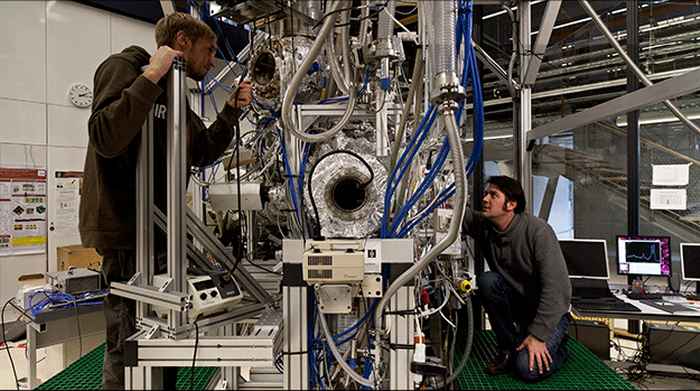Alumnus on the job

FAMOS
‘This instrument allows us to explore the electronic structure of new, special materials such as superconductors and topological insulators. The FAMoS works on the basis of the photoelectric effect, whereby electrons can detach themselves from atoms when the material of interest is exposed to light. In the instrument, materials are exposed to light, which consists of photons with a specifically defined energy. The electrons absorb these photons and gain enough energy to leave the material. After that, the kinetic energy and the angle at which the electrons leave the material are measured. On the basis of energy and impulse conservation, an assessment can be made as to how the electrons behave in the material.’
Where the action takes place
Because of the confusion of wires, cables, pipes and aluminium foil, it is difficult to estimate where the action actually takes place. De Jong explains that the device consists of roughly three parts.
‘The first part is the load block, which is the spot where samples are loaded. This is necessary because measurements are conducted in an ultra-high vacuum, of a magnitude of 14 times lower than atmospheric pressure. Without this ultra-high vacuum, the materials would be contaminated by gas particles in the air. After this first step the sample is moved to the prep-chamber, short for “preparation chamber”. In this chamber the sample is halved to create as clean a surface as possible. Last, there is the main chamber – the chamber in the centre of the photo. This is where all the measurements are carried out. The material is moved here in what’s known as a manipulator. The manipulator can move the material in three directions and turn it at three different angles. The sample can also be cooled to -253.15° C.’
One-dimensional (1D) metals
Nick de Jong actually helped design and develop the chamber he is looking into on the photo. It was needed for his research into one-dimensional (1D) metals. ‘The prep-chamber was not sufficient for my own research because 1D metals cannot be made in the same way as the materials we have researched up to now. 1D metals consist of rows of gold atoms which are just a single atom wide and lie on an insulating substrate. They have to be made in the equipment itself. The substrate of the gold threads is first cleaned by heating the isolator to 1,000 degrees Celsius and then sputtering the surface using an argon ion gun. This process can be compared to spray cleaning a garden tile using a high-pressure spray gun. After that, gold atoms can be applied to the surface. The special structure of the surface means the atoms end up positioned neatly in rows. The expectation is that these 1D rows will have very special properties.’